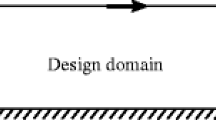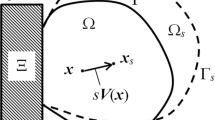Abstract
The paper presents a direct shape optimization approach that minimizes both boundary stress concentration and peak contact pressure of multi-body contact systems. This approach is centered on the direct shape modification of boundary regions of stress concentration measured by von Mises stresses and contact surfaces measured by contact pressure. Without requiring sensitivity data for shape modification, shape optimization is made directly on nodal positions through an iterative computational scheme. Therefore, this approach is simple to implement using either commercial finite element software or in-house programs. An adjustable weighting factor is used to ensure stable and accelerated convergence in shape optimization. To evaluate the proposed approach, three case problems are presented, and the results show that this direct shape optimization approach can be especially applicable to the design and analysis of multi-body systems where boundary stress concentration and contact pressure distribution are an important consideration.
Similar content being viewed by others
References
E. Schnack, An optimization procedure for stress concentrations by the finite element technique. Int. J. Numer. Meth. Engng, 14 (1979) 115–124.
M. Heller, R. Kaye and L. R. F. Rose, A gradient-less finite element procedure for shape optimization. J. Strain Analysis, 34(5) (1999) 323–336.
C. Mattcheck and S. Burkhardt, A new method of structural shape optimization based on biological growth, Int. J. Fatigue, 12(3) (1990) 185–190.
W. Li, Q. Li, G. P. Steven and Y. M. Xie, An evolutionary shape optimization procedure for contact problems in mechanical designs, Proc. IMechE, Part C: J. Mech. Engrg. Sci., 217 (2003) 435–446.
W. Li, Q. Li, G. P. Steven and Y. M. Xie, An evolutionary shape optimization for elastic contact problems subject to multiple load cases, Comput. Methods Appl. Mech. Engrg., 194 (2005) 3394–3415.
R. T. Haftka and R. V. Gandhi, Structural shape optimization-A survey, Comput. Meths. Appt. Mech. Engrg., 57 (1986) 91–106.
M. P. Bendsoe and O. Sigmund, Topoloy optimization: theory, methods and applications, Springer, Berlin (2003).
X. Huang and M. P. Xie, Evolutionary Topology Optimization of Continuum Structures: Methods and Applications, John Wiley & Sons, West Sussex (2010).
Y. M. Xie and G. P. Steven, A simple evolutionary procedure for structural optimization, Comput. Struct., 49(5) (1993) 885–896.
O. M. Querin, G. P. Steven and Y. M. Xie, Evolutionary structural optimisation (ESO) using a bidirectional algorithm, Engrg. Comput., 15(8) (1998) 1031–1048.
G. I. N. Rozvany, A critical review of established methods of structural topology optimization, Struct. Multidisc. Optim., 37 (2009) 217–237.
K. H. Chang et al., Design sensitivity and optimization tool (DSO) for shape design applications, Comp. Sys. Engrg., 6(2) (1995) 151–175.
M. Papadrakakis et al., Advanced solution methods in topology optimization and shape sensitivity analysis, Engrg. Comp., 13(5) (1996) 57–90.
W. H. Zhang, P. Beckers and C. Fleury, A unified parametric design approach to structural shape optimization, Int. J. Numer. Meth. Engng., 38(13) (1995) 2283–2292.
C. Le, T. Bruns and D. Tortorelli, A gradient-based, parameter-free approach to shape optimization, Comput. Methods Appl. Mech. Engrg., 200(9–12) (2011) 985–996.
F. O. Sonmez, Shape optimization of 2D structures using simulated annealing, Comput. Methods Appl. Mech. Engrg., 196(35–36) (2007) 3279–3299.
K. K. Pathak and D. K. Sehgal, Gradient-less shape optimization using artificial neural networks, Struct. Multidisc. Optim., 41(5) (2009) 699–709.
M. Burchill and M. Heller, Optimal notch shapes for loaded plates, J. Strain Analysis, 39(1) (2004) 99–116.
R. Meske, J. Sauter and E. Schnack, Nonparametric gradient-less shape optimization for real-world applications, Struct. Multidisc. Optim., 30 (2005) 201–218.
F. O. Sonmez, Optimal shape design of shoulder fillets for flat and round bars under various loadings, Proc. IMechE, Part C: J. Mech. Engrg. Sci., 223 (2009) 1741–1754.
K. Johnson, Contact Mechanics, Cambridge University Press, Cambridge (1985).
E. A. Fancello and R. A. Feijoo, Shape optimization in frictionless contact problems, Int. J. Numer. Meth. Engng., 37 (1994) 2311–2335.
D. Hilding, B. Torstenfelt and A. Klarbring, A computational methodology for shape optimization of structures in frictionless contact, Comput. Methods Appl. Mech. Engrg., 190 (2001) 4043–4060.
N. H. Kim, K. K. Choi and J. S. Chen, Shape design sensitivity analysis and optimization of elastic-plasticity with frictional contact, AIAA J., 38(9) (2000) 1742–1753.
V. Vondrak et al., Parallel solution of contact shape optimization problems based on total FETI domain decomposition method, Struct. Multidisc. Optim., 42 (2010) 955–964.
W. Song et al., Turbine blade fir-tree root design optimisation using intelligent CAD and finite element analysis, Comput. Struct., 80 (2002) 1853–1867.
Author information
Authors and Affiliations
Corresponding author
Additional information
Recommended by Associate Editor Tae Hee Lee
Hengan Ou received his Ph.D. from the University of Strathclyde, UK in 2001. He worked as an associate professor in the Department of Mechanical, Materials and Manufacturing Engineering, University of Nottingham. His main research interests are in process modeling and optimization, metal forming and material processing techniques as well as machine system design and integration.
Bin Lu received his Ph.D. from the Queen’s University of Belfast, UK in 2008. He worked as an associate professor in National Engineering Research Centre of Die & Mold CAD, Shanghai Jiao Tong University. His main research interests are incremental sheet forming, preform design and net-shape forging.
Rights and permissions
About this article
Cite this article
Ou, H., Lu, B., Cui, Z.S. et al. A direct shape optimization approach for contact problems with boundary stress concentration. J Mech Sci Technol 27, 2751–2759 (2013). https://doi.org/10.1007/s12206-013-0721-7
Received:
Revised:
Accepted:
Published:
Issue Date:
DOI: https://doi.org/10.1007/s12206-013-0721-7




